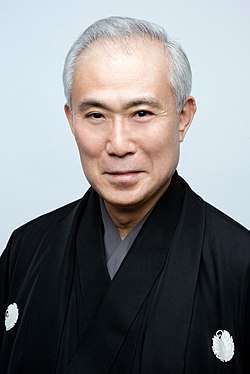Nakamura Kichiemon II
| Nakamura Kichiemon II 二代目中村吉右衛門 | |
|---|---|
 Nakamura Kichiemon II | |
| Born |
Tatsujirō Namino 22 May 1944 Tokyo, Japan |
| Other names | Harimaya, Nakamura Mannosuke, Matsu Kanshi II |
Nakamura Kichiemon II (二代目 中村 吉右衛門 Nidaime Nakamura Kichiemon, born May 22, 1944), born Namino Tatsujirō, is a Japanese actor, kabuki performer and costume designer. He is a so-called Living National Treasure.[1]
Nakamura Kichiemon is a formal kabuki stage name. The actor's grandfather first appeared using the name in 1897; and Nakamura Kichiemon I continued to use this name until his death.[2] Kichiemon I was the maternal grandfather of Kichiemon II.[3]
In the conservative Kabuki world, stage names are passed from father to son in formal system which converts the kabuki stage name into a mark of accomplishment.[4] In choosing to be known by the same stage name as his grandfather, the living kabuki performer honors his family relationships and tradition.
Early life
Born in Kōjimachi, Chiyoda, Tokyo. His elder brother is Matsumoto Kōshirō IX. His father was Ichikawa Somegorō V, later known as Matsumoto Kōshirō VIII, and finally as Matsumoto Hakuō I. His mother was Seiko Fujima, Nakamura Kichiemon I's daughter and only child. According to Kichiemon II himself, his grandfather was "furious" and couldn't accept that his only child was a girl (due the fact that in Kabuki there are no actress it meant that he couldn't give his name to his daughter), and treated her like a boy during her childhood. As a result, when she got married, Seiko promised her father that she would have at least two sons: the first would have carried his husband's traditions, while the second would have carried his name. She kept her promise and gave to adoption Kichiemon II to his grandfather. Unlike the most of Kabuki actors, who are only formally adopted when joining an acting family, he was legally adopted by his grandfather.
He attended Waseda University. His yagō is "Harimaya" and his crest is the ageha-no-chō butterfly of the Taira clan.
Career
Active in kabuki and television, Kichiemon is famous in the role of Musashibō Benkei, whom he has portrayed on stage in Kanjinchō and Yoshitsune Senbon Zakura. He also played the title character in the NHK jidaigeki series Musashibō Benkei. Another heroic role was Ōboshi Yuranosuke (the historical Ōishi Kuranosuke) in Kanadehon Chūshingura, the story of the Forty-seven Ronin.
He assumed the television role of Hasegawa Heizō ("Onihei") in the Shōtarō Ikenami series Onihei Hankachō. It ran through nine series, from 1989 to 2001, and has recurred in short series and specials since, the most recent being in 2007. His father had previously played Onihei.
Selected works
Nakamura's published writings encompass 25 works in 34 publications in 3 languages and 543 library holdings.[5]
- 2000 — Kichiemon's palette (吉右衛門のパレット / Kichiemon no paretto) ISBN 9784104425013; OCLC 48917600
- 1996 — A long story (語り monogatari) ISBN 9784838707089; OCLC 36046366
Honors
- Japan Art Academy, 2002.[6]
- Living National Treasure, 2011
- Person of Cultural Merit, 2017
Filmography
| Date | Title | Type | Role |
|---|---|---|---|
| 1960 | The River Fuefuki | Film | Yasuzō |
| 1962 | Chūshingura: Hana no Maki, Yuki no Maki | Film | Sanpei |
| 1968 | Kuroneko | Film | Kindoki |
| 1969 | Double Suicide | Film | Kamiya Jihei |
| 1989 | Rikyu | Film | Tokugawa Ieyasu |
| 1989–2016 | Onihei Hankachō | TV | Hasegawa "Onihei" Heizō |
| 2014 | Zakurozaka no Adauchi | Film | Ii Naosuke |
See also
Notes
- ↑ http://mdn.mainichi.jp/arts/news/20110823p2a00m0na006000c.html
- ↑ Leiter, Samuel. (2006). Historical Dictionary of Japanese Traditional Theatre, p. 260., p. 260, at Google Books
- ↑ 母方の祖父 (maternal grandfather) Archived 2012-10-22 at the Wayback Machine.
- ↑ Scott, Adolphe Clarence. (1955). The Kabuki Theatre of Japan, p. 159., p. 159, at Google Books
- ↑ WorldCat Identities: 中村吉右衛門 1944-.
- ↑ 中村 Archived 2009-08-29 at the Wayback Machine.
References
- Leiter, Samuel L. (2006). Historical Dictionary of Japanese Traditional Theatre. Lanham, Maryland: Scarecrow Press. ISBN 978-0-8108-5527-4; OCLC 238637010
- Scott, Adolphe Clarence. (1955). The Kabuki Theatre of Japan. London: Allen & Unwin. OCLC 622644114
External links
- Japan Art Academy (in Japanese)
- Nakamura Kichiemon II on IMDb
- JMDB